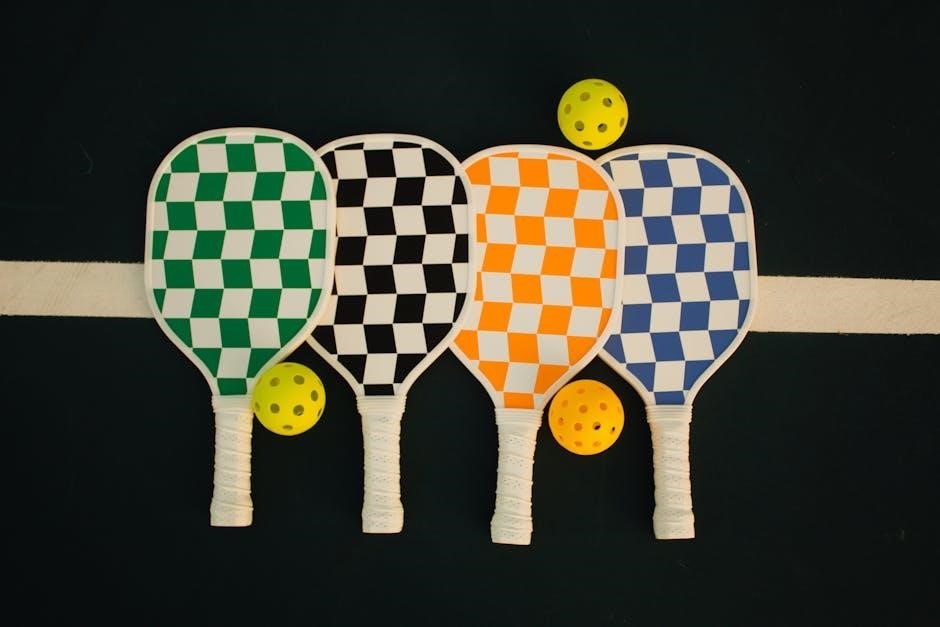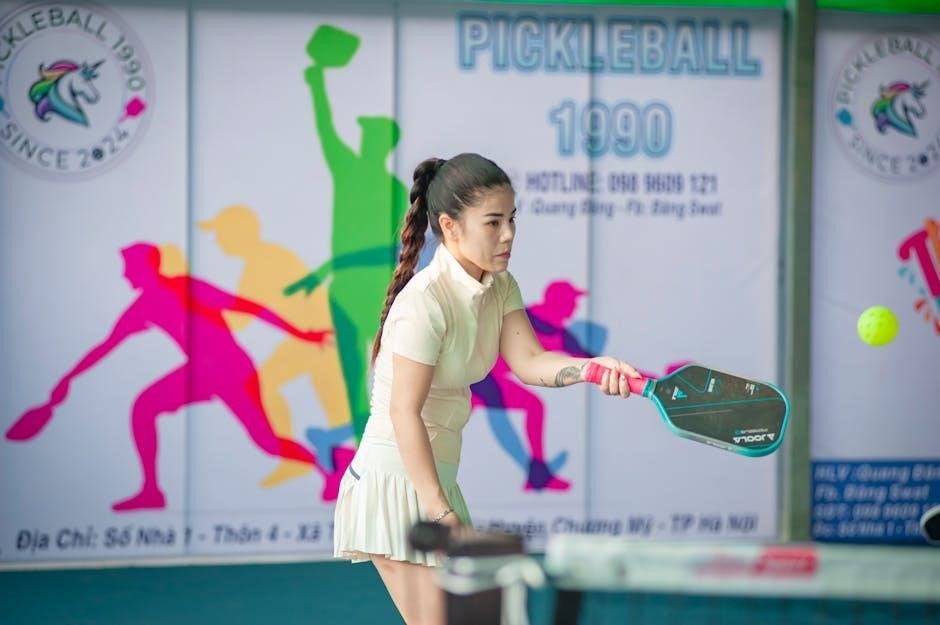Welcome to our comprehensive guide! Choosing the right pickleball paddle can elevate your game, but with so many options, it can feel overwhelming. This guide helps you navigate the process, ensuring you find the perfect paddle tailored to your needs, skill level, and playing style. Whether you’re a beginner or an advanced player, this guide covers everything from core materials to handle size, helping you make an informed decision. Let’s get started!
1.1 Understanding the Importance of Choosing the Right Paddle
Selecting the right pickleball paddle is crucial for optimizing performance and enjoyment. The paddle’s weight, size, and material significantly impact control, power, and comfort. A paddle that suits your style enhances accuracy and reduces fatigue, while the wrong choice can hinder technique and enjoyment. With so many options available, understanding your needs ensures a better fit, helping you play your best game. This guide simplifies the process, empowering you to make an informed decision tailored to your unique preferences and skill level.
1.2 Overview of Key Factors to Consider
When selecting a pickleball paddle, several key factors must be considered to ensure the best fit. Core material and thickness impact durability and performance, while surface material affects spin and control. Weight and balance influence maneuverability and power, and handle length and grip size ensure comfort and precision. Paddle shape and size can enhance gameplay, and price and warranty are important for value and protection. Understanding these elements helps narrow down options, ensuring the paddle aligns with your skill level and playing style. This guide explores each factor in detail to simplify your decision-making process.
Key Characteristics of Pickleball Paddles
Understanding the key characteristics of pickleball paddles is crucial for making an informed decision. Core material, thickness, surface durability, weight, handle length, grip size, shape, and price are essential factors to evaluate.
2.1 Core Material and Thickness
The core material and thickness significantly impact a pickleball paddle’s performance. Common core materials include polypropylene, which offers durability and power, and Nomex, known for its lightweight and responsive feel. Thickness varies, with standard cores ranging from 10mm to 16mm. Thicker cores provide more power, while thinner ones enhance control and precision. For beginners, a medium-thick core (12-14mm) strikes a balance, while advanced players may prefer specialized thicknesses based on their playing style. Choosing the right core material and thickness ensures optimal performance and comfort during gameplay.
2.2 Surface Material and Durability
The surface material and durability of a pickleball paddle are critical for performance and longevity. Graphite surfaces are lightweight, durable, and offer excellent pop, while composite materials provide a softer feel and are often textured for enhanced spin control. Durable surfaces resist scratches and chips, ensuring consistent play over time. Edge guards and protective coatings further enhance longevity, especially for players with aggressive styles. When choosing, balance surface material with your playing style—graphite for power and composite for control. Durable paddles withstand rigorous use, making them a worthwhile investment for dedicated players seeking consistent performance and extended lifespan.

2.3 Weight and Balance
Pickleball paddles vary in weight and balance, impacting performance and comfort; Lighter paddles (7.5–8.5 oz) offer quick handling and control, ideal for fast plays and precise shots. Mid-weight paddles (8.5–9.5 oz) strike a balance between power and maneuverability. Heavier paddles (9.5–12 oz) deliver maximum power but may tire arms over time. Balance refers to weight distribution—head-heavy paddles favor power, while handle-heavy designs enhance agility. Choose a weight that matches your strength and style, ensuring durability for long-term use. Proper balance optimizes swing speed and control, making it a key factor in enhancing your gameplay experience. Always test the feel before committing to a paddle.
2.4 Handle Length and Grip Size
Handle length and grip size are crucial for comfort and control. Most paddles have handles ranging from 4 to 6 inches, with longer handles suiting two-handed players. Grip size varies, but standard sizes are 4–4.5 inches in circumference. A larger grip reduces wrist movement, while a smaller grip enhances feel. Ensure the grip fits your hand snugly to avoid slipping. Some paddles allow for adjustable grips, letting you customize the fit. Proper handle length and grip size maximize comfort and performance, reducing fatigue during extended play; Test different sizes to find your ideal combination for a confident and controlled swing.
2.5 Paddle Shape and Size
Pickleball paddles come in various shapes and sizes, each offering unique advantages. The standard size is 8×24 inches, but some models vary slightly. A wider paddle provides a larger sweet spot, ideal for beginners, while narrower shapes suit precise shots. The shape can also affect balance and maneuverability. Some paddles feature rounded edges for a forgiving hit, while others have more angular designs for control. Ensure your paddle meets USAPA regulations if you plan to play competitively. The right shape and size enhance your performance, making every swing more efficient and effective. Consider your style when choosing the perfect fit.

2.6 Price and Warranty
Pickleball paddles vary in price, ranging from $40 to $300, depending on materials and features. Entry-level paddles are budget-friendly, while premium options offer advanced technologies. Warranty terms are crucial for protecting your investment. Most manufacturers provide a 1-year warranty, but some extend up to 5 years. Look for warranties covering defects in materials and workmanship. Ensure the warranty aligns with your needs and consider brands offering extended coverage. When purchasing, always check the warranty details to ensure peace of mind and long-term satisfaction with your paddle choice.
Choosing the Right Paddle for Your Skill Level
Whether you’re a beginner, intermediate, or advanced player, selecting a paddle tailored to your skill level ensures optimal performance and enjoyment on the court. This section guides you through the process, helping you identify the best features for your game, from lightweight designs for newcomers to high-performance materials for seasoned competitors.
3.1 Paddles for Beginners
For those new to pickleball, a paddle with forgiveness and ease of use is essential. Beginners benefit from a lightweight design, typically between 7-9 ounces, allowing for better control and maneuverability. A larger sweet spot and softer core material, such as polymer, provide consistency and reduce vibration; Look for paddles with durable yet textured surfaces for improved spin control. Additionally, a longer handle or cushioned grip can enhance comfort and reduce fatigue. These features help build confidence and skill, making the learning process enjoyable and effective for new players stepping onto the court.
3.2 Paddles for Intermediate Players
Intermediate players seeking to refine their skills benefit from paddles offering a balance of power, control, and precision. Look for paddles with a medium weight range, typically 8-10 ounces, allowing for better energy transfer while maintaining maneuverability. Core materials like polymer or composite provide excellent pop and durability. A textured surface enhances spin control, while a slightly smaller sweet spot encourages accuracy. Handles should be comfortable yet responsive, supporting advanced shots. USAPA certification ensures compliance with tournament standards. These features help intermediate players improve their technique and execute a variety of shots with confidence and consistency on the court.
3.3 Paddles for Advanced Players
Advanced players require paddles designed for precision, power, and control. Lightweight paddles (7-8 ounces) made from high-quality materials like carbon fiber or advanced composites are ideal, offering superior pop and responsiveness. A balanced or head-heavy weight distribution optimizes power for aggressive shots. Textured surfaces enhance spin generation, while slim profiles allow for quicker reactions. USAPA certification ensures tournament compliance. Edge guards and durable constructions withstand intense play. These paddles cater to experienced players seeking to refine their techniques and deliver precise, powerful shots. They are engineered for performance, helping advanced players dominate the court with consistency and finesse.

Additional Features to Consider
Beyond the basics, consider edge guards for protection, textured surfaces for spin control, and USAPA certification for tournament play. These features enhance performance and durability, ensuring your paddle meets both personal and competitive standards while maintaining optimal playability and longevity. These thoughtful additions can make a significant difference in your game, offering both functionality and peace of mind for players of all levels. They are essential for maximizing your pickleball experience and investment in the right equipment.
4.1 Edge Guards and Protection
Edge guards are essential for protecting your pickleball paddle from damage caused by mishits or accidental impacts. These protective strips, usually made of durable materials like PVC or polypropylene, are applied around the paddle’s edges. They prevent chips, cracks, and premature wear, extending the paddle’s lifespan. High-quality edge guards also enhance the overall durability of the paddle, ensuring consistent performance over time. For players who value longevity and reliability, investing in a paddle with a robust edge guard is a wise decision. This feature is particularly beneficial for competitive play and heavy use, safeguarding your investment and maintaining optimal playability.
4.2 Textured Surfaces for Spin
Textured surfaces on pickleball paddles are designed to enhance spin control, allowing players to impart more rotation on the ball. These surfaces feature subtle patterns or ridges that create additional friction when striking the ball. This increased grip enables sharper angles and greater precision for shots like topspin, sliced shots, and drop shots. Players who prioritize strategic play and advanced techniques benefit significantly from textured surfaces. However, it’s important to ensure the texture complies with USAPA regulations to avoid disqualification. Balancing spin potential with durability is key, as overly aggressive textures may compromise the paddle’s longevity.
4.3 USAPA Certification
USAPA certification is a critical factor when selecting a pickleball paddle, as it ensures compliance with official standards. The USA Pickleball Association (USAPA) sets strict guidelines for paddle materials, size, and surface texture to maintain fair play. Paddles must pass rigorous testing to meet these requirements, which include restrictions on noise levels, deflection, and roughness. Using a non-certified paddle can result in disqualification during sanctioned tournaments. Always look for the USAPA logo to confirm compliance. This certification not only guarantees eligibility for competitive play but also ensures your paddle meets safety and performance standards, providing a fair and enjoyable gaming experience for all players.

Step-by-Step Guide to Selecting the Perfect Paddle
Start by assessing your play style, skill level, and preferences. Narrow options based on core material, weight, and handle size. Evaluate features like surface texture and edge guards. Consider your budget and warranty offerings. Test paddle feel if possible. Compare top models and read reviews. Finally, make an informed decision that aligns with your needs for optimal performance and enjoyment on the court.
5.1 Assessing Your Playing Style
Understanding your playing style is crucial in selecting the right pickleball paddle. Consider whether you’re a power hitter, focused on strong swings, or a control player, prioritizing precision and finesse. If you’re a beginner, durability and ease of use are key. Intermediate players may balance both power and control, while advanced players often seek specialized features like textured surfaces for spin. Your style influences choices in weight, material, and handle length. Reflect on your game to identify preferences, ensuring your paddle complements your strengths and improves your performance. This step sets the foundation for narrowing down options effectively.
5.2 Narrowing Down Your Options
Once you’ve assessed your playing style, it’s time to narrow down your options. Start by prioritizing the features that matter most to you, such as core material, weight, or handle length. Consider your budget and set a price range to focus on paddles within your means. Use tools like the Paddle Finder or comparison charts to filter options based on your preferences; Read reviews and expert recommendations to gain insights into how specific paddles perform. Finally, test a paddle if possible, ensuring it feels right in your hands and aligns with your style. This step helps you identify the best fits efficiently.
5.3 Making the Final Decision
After narrowing your options, it’s time to make the final decision. Evaluate which paddle best aligns with your needs, budget, and playing style. Consider expert recommendations and user reviews for insights. If possible, test the paddle to ensure it feels comfortable and performs well. Check for USAPA certification if you plan to play in tournaments. Finally, compare warranties and customer support offered by manufacturers. By weighing all these factors, you’ll confidently select a paddle that enhances your game and provides long-term satisfaction. Remember, the right paddle is an investment in your pickleball journey.

Be First to Comment